Jewelry
boxes and cabinets

Request
current list of available Jewelry boxes.
writing-boxes
jewelry-boxes
tea caddies
sewing-boxes
contents
| |
\
Antique Red tortoiseshell and brass Boulle casket Circa 1750.
Please click on images to enlarge | slide show | thumbnail index |Request
current list of available Jewelry boxes.
Reference: JB314
Description:
A shaped casket covered in boulle work of brass and red tortoiseshell,
with guilt ormolu mounts and feet. The pattern is in bold swirls forming
floral designs and cusps typical of 18th century work. The brass
is engraved to give dimension to the design. The top is built around a
stage where a musician sits playing his instrument. A complex
composition, opulent and at the same time whimsical. The box is lined
with silk. Circa 1750
Origin: France
Circa: 1750
Size: 32 cm wide by 27 cm by 12.8 cm including feet: 12.6 inches wide by
10.6 inches
by 5 inches.
Condition: Good
overall.
|
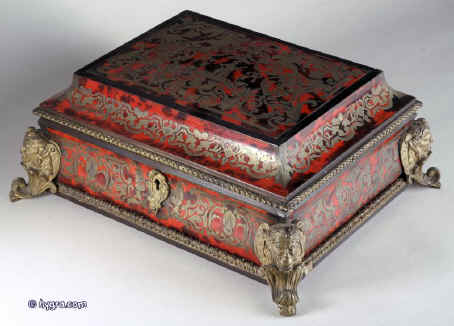
|
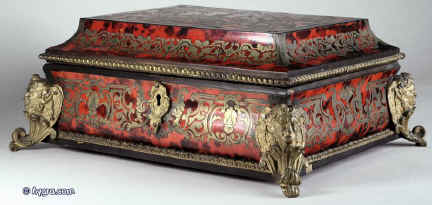
|
See:
Antique
Boxes, Tea Caddies, and Society, 1700--1880
Antigone Clarke & Joseph O'Kelly, ISBN: 0764316885
"Marquetry
of alternating metal and shell originated in Italy, but it was not
widely practiced until the technique was advanced by A.C. Boulle
(1642-1732) ébéniste to Louis XIV. This kind of work found
favor in England throughout the 18th and 19th centuries. Boulle's
technique involved the cutting of patterns in sheets of tortoiseshell
and brass, which were secured one on top of the other. The resulting
half sheets were then used to veneer the wooden surface of the box, or
piece of furniture.
|
Please click on images to enlarge | slide show | thumbnail index |Request
current list of available Jewelry boxes.
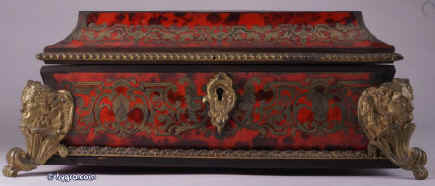
|
"They
were fitted together, one brass sheet into one shell sheet, or vice
versa. The brass into shell was referred to as première partie
and the shell into the brass, contre partie. The surface
to be veneered was gessoed and usually colored red.
|
"The
shell was sometimes backed with foils. In early pieces, the whole veneer
was sometimes backed by canvas before it was stuck onto the wooden
surface. Different makers had their own techniques and order for
preparing and coloring the base before attaching the final marquetry
veneer. Ivory, wood, horn, silver, mother of pearl, and other materials
were incorporated in larger more ambitious designs. This work, which has
a distinctive French flavor, is often attributed to French makers. In
some cases this is correct, as boxes made in France did find their way
to England . However, this is not always the case.
|
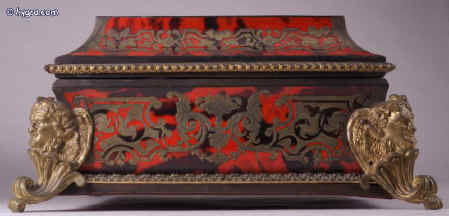
|
Please click on images to enlarge | slide show | thumbnail index |
"Gerrit
Jensen (1680-1715) was the first major exponent of the work in England.
He was a Royal maker of great repute. What is interesting for our
purpose is that in the patent renewing his appointment as "Cabinet
Maker In ordinary" to William and Mary, "Cabbinets Boxes"
are listed as part of his work. It is therefore possible that some early
18th century boulle boxes originated in England and not in France.
|
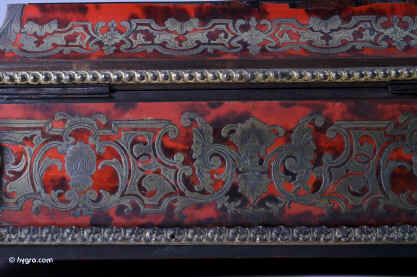
|
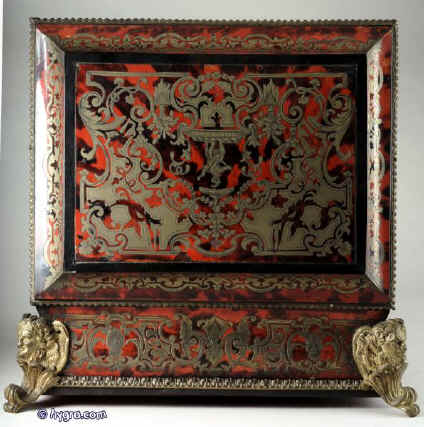
|
"However,
some of the London makers did originate in France . There is evidence
that Jensen employed French workers, as did other cabinet makers during
the 18th and 19th centuries. Some French cabinet makers worked in
England on their own account.
"Pierre
Langlois, one of the pioneers of this work, was active in London during
the 1760s and 70s. His trade card was designed very much in the French
style, complete with rococo scrolls and putti. It was printed both in
English and French. He offered brass and tortoiseshell inlays "in
the Politest Manner" and also careful repairs. He promised
"Lowest Prices".
|
Please click on images to enlarge | slide show | thumbnail index |Request
current list of available Jewelry boxes.
Please click on images to enlarge | slide show | thumbnail index |
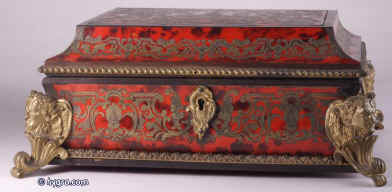
|
A
|
Please click on images to enlarge | slide show | thumbnail index |Request
current list of available Jewelry boxes.
All text and images and linked images are ©
1999-2008 Antigone Clarke and Joseph O'Kelly. If you require any further
information on permitted use, or a licence to republish any material, email us
at copyright@hygra.com
|
